I had one jar of peach and pecan preserves from Mercier's that I brought back with me from Christmas to share with the special people in my life. I put the jam and a small American chocolate bar in a gift bag and presented it to the woman who I assumed to be the lady of the house. "What? Do you want to give that to my mother?" Elvira asked me.
"Um...yes..." I said.
"Oh! This is my aunt!"
Whoops. Elvira introduced me to her mom, and I gave the gift, with a cheesy introduction about it being a present from my family to hers, to thank her for allowing me to stay, etc. She curiously pulled the jam out of the bag.
"Is this...food?" she asked. "Oh, I see. It's medicine. Or is it food?"
"Ah...it's food. It's jam! You can, you know, put it on bread, or something."
"Hmm...I've never seen anything like this. But...thanks."
Well, I thought. That couldn't have gone any worse.
Luckily, the weekend got much better from there. Elvira, who has seven brothers and sisters, is a part of a large, happy and kind family. It was a real honor to share this most important holiday in Guatemala with them.
I'm still not sure why, but they celebrate the most on Thursday and Friday. Thursday is the "dia de comer," the day when neighbors exchange loaves of homemade bread and a dish of sweet, stewed fruit that they only make once a year.
Friday we went down into the town proper to watch processions. For anyone not familiar with the Easter traditions of Spain, Portugal and their "subsidiaries," on Easter, many people dress up in a loose interpretation of what the people of Jesus' time would wear--robes, romanesque helmets, etc. Then they carry large, Easter-themed parade floats through town on their shoulders, flanked by incense swinging youths.
Resurrection Sunday, which gets all the attention back in the States, is much less of a big deal here, though I'm not sure why.
But this family brought up an interesting question for me. So, in my project, there are three main technologies we try to bring to people (and two others that are not done as much): cement floors, better stoves, and latrines. Now, this family had a latrine and a better stove. But they were lacking a cement floor, which is, for many people, where you start. Having a dirt floor makes contamination in the kitchen and all around the house so much more of a problem. However, this family has invested so much in their children. My friend Elvira is a nurse. Her older brother is a teacher who once gained a scholarship for international travel and has visited Norway. All of the younger children are in school and are motivated to do well. They have adequate nutrition and good hygiene. So I ask myself...how much would this family benefit from a cement floor? Obviously they are way ahead of many other rural families when it comes to education, hygiene and nutrition. Would it be better if they sold their pig, horse or sheep to purchase a cement floor? Or if one of their kids had to drop out of school to finance it? I am inclined to say no.
This family was a great example to me of how complicated development is. Having technology does not guarantee better health, and the lack of technology does not damn you to a life of diarrhea and respiratory infection.
It's more complex than that.

No comments:
Post a Comment